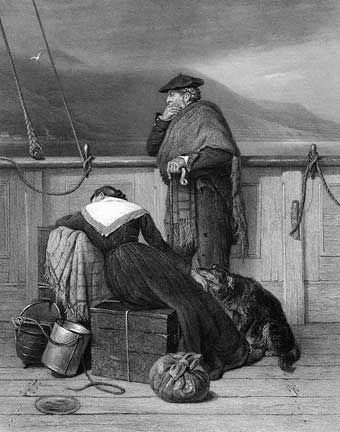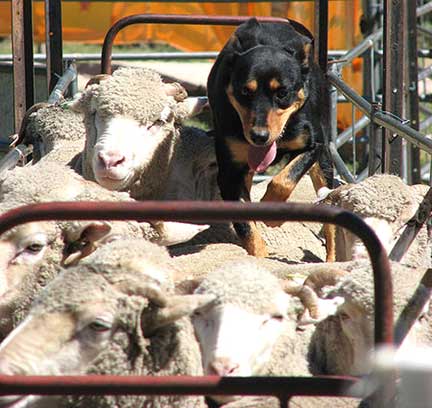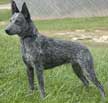

![]()
BORDER COLLIE COUSINS
THE COLLIE BREEDS OF AUSTRALIA AND NEW ZEALAND

"Lochaber No More" by John Watson Nicol (1856-1926)
shows a Highland couple emigrating to the colonies
with all their belongings, and their black-and-tan collie.
Painted in 1883, this is likely Nicol's most famous painting.
INTRODUCTION TO THE COLLIE BREEDS OF AUSTRALIA AND NEW ZEALAND
On previous pages we introduced the Border Collie cousins of Britain and Ireland and of North and South America. Here we introduce the Collie Breeds of Australia and New Zealand. All the Australian and New Zealand breeds are closely related to and indeed descended from the old working collies of Great Britain and Ireland of the 18th, 19th and 20th centuries.
"British Shepherds four centuries ago, used dogs that were ancestors of those working in Australia" said R.B. Kelley (1890-1970), a veterinarian, animal geneticist (prior to the discovery of DNA), and past president of the New South Wales Working Working Sheep Dog Society.[3] As in the Americas, collies came to Australia and New Zealand in a variety of ways. Some of them accompanied shipments of sheep from Britain and elsewhere. Others were brought by their owners when they immigrated and settled on sheep and cattle farms or stations (ranches). Some were sent for by farmers, shepherds and stockmen who fondly remembered the working dogs of their homeland and thought none could compare. These dogs were of a variety of types that eventually developed as breeds in their new country. So, while they are descended from British ancestry, they are today truly Australian and New Zealand breeds and types. However, individuals of the Australian and New Zealand collie breeds have been exported to other countries, particularly the United States, where they have undergone further changes to emerge as somewhat different types than their relatives that remained Down Under. It may be interesting to examine these "remodeled" breeds as well.
Wool has always been a crucial industry in Australia, and as of 2001 Australian wool accounted for 9% of the world's wool production and 50% of the world's fine quality wool yield. The lamb meat industry is becoming increasingly important as wool has been declining. Australia's cattle industry is of major importance, as beef production is currently the biggest agricultural sector, and Australia is the second largest beef exporter, behind Brazil.[5] The meat and wool industries contribute almost 30% to the gross value of agriculture in Australia and over 40% of the total area is devoted to sheep and cattle production.[6] Therefore, it stands to reason that sheep and cattle dogs would be of paramount importance in a country where sheep and cattle stations are enormous and animals have to be moved frequently.
What sort of dogs would have been chosen for the job of herding Australian sheep and cattle? Kelley said, "the environment in which dogs work is critical for their physiological and anatomical attributes of usefulness. In the Old Country [as he calls Great Britain] intense cold is the most important single climatic factor...[and] under these conditions, long coats for warmth, dropped ears to prevent accumulation of sleet in the external ear, and wide-spread feet to give maximum bearing surface on the snow, are essential. In Australia the circumstances are altogether different, with intense heat to be endured...Burrs and sharp seeded grasses abound in most areas and dogs with wide-spread, hairy feet or with feather on the legs are at a considerable disadvantage. Distances to be travelled in the day's work are also different in the two countries, as are the size of flocks and the nature of the sheep. It is therefore unwise to surmise that the type of dog well suited for the United Kingdom is of necessity proper for Australian conditions." Dogs developed in Australia met the needs of those conditions.
In New Zealand, wool was the major agricultural export during the 19th and first half of the 20th century, but has been in a steady decline. However, within the livestock industry, sheep are still dominant, with more than 46 million sheep raised as compared to just over 8 million cattle (both beef and dairy). Sheep and cattle are predominantly grass fed, either intensively on highly productive lowland pastures, or on lower production highland pastures.[25] As in Australia, sheep and cattle stations are large and herding dogs are extremely important.
 A Kelpie backing sheep. (Photo by Peter Shanks from Wikimedia.com and licensed under Creative Commons Attribution 2.0 Generic.)
A Kelpie backing sheep. (Photo by Peter Shanks from Wikimedia.com and licensed under Creative Commons Attribution 2.0 Generic.)
We can't leave Australia and New Zealand without mention of that very special trait in herding dogs in both Australia and New Zealand, that of the "Backing Dog". Kelley says: "In sheep yards the dog that will 'back' probably is the most specialized. These dogs require favourable conditions, principal of which is that sheep should be crowded up tightly, particularly until the dogs become expert. Such conditions occur most frequently at big sale yards and it is there that 'backing' dogs are seen at their best. Their function is to go forward up the races and down the lanes over the tightly packed sheep's backs and, by barking vigorously, cause the leading sheep to keep moving."
Today, because the world is so much smaller than it was in the past, and because people have access to media that can show them how people in other places do things, backing may be becoming more prevalent, dare I say, trendy, in sheepdog circles in countries other than Australia and NZ. Or perhaps there have always been some people who utilize backing everywhere, but quietly without publicity.
Resources:
Presberg, Carole L. "The History of the Shepherd's Dog, Part XII: Border Collie Cousins, The Collie Breeds of Britain and Ireland", International Sheepdog News, January/February 2012.
Presberg, Carole L. "The History of the Shepherd's Dog, Part XIII: Border Collie Cousins, The Collie Breeds of America", International Sheepdog News, March/April 2012.
Kelley, R. B. Sheep Dogs, Their Breeding, Maintenance, and Training, Angus & Robertson, 1947.
Wikipedia: "Australia"
Barson, M., Mewett, J. and Paplinska, J. 2011 Land management practice trends in Australia’s grazing (beef cattle/sheep) industries. Caring for our Country Sustainable Practices fact sheet 2, Department of Agriculture, Fisheries and Forestry (Australia).
Charteris, P.L., Morris, S.T., and P.N.P. Matthews. "Pasture-Based Beef Production in New Zealand", Institute of Veterinary Animal and Biomedical Sciences Massey University, Palmerston North New Zealand.
Copyright © 2013 by Carole L. Presberg
Return to
![]()
BORDER COLLIE COUSINS
or click below on the dog(s) you want to read about
 The Australian Cattle Dog |

The Australian Stumpy-Tail Cattle Dog |
 The Australian Kelpie |
 The Barb |
 The Australian Koolie |
 The Smithfield |

The Working Collies of New Zealand |
THE OTHER WEB PAGES WE MAINTAIN
These web pages are copyright ©2013
and maintained by webmeistress Carole Presberg
with technical help from webwizard David Presberg
ALL RIGHTS RESERVED
If you are interested in using ANY material on this website, you MUST first ask for permission.